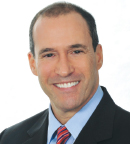The use of prostate-specific antigen (PSA) screening has led to a dramatic rise in the number of men diagnosed with low-grade prostate cancer. Active surveillance is recommended to manage patients with favorable-risk, low-grade prostate cancer, with the goal of avoiding overtreatment of these patients, many of whom may never progress to more aggressive cancer during their lifetimes.
However, the active surveillance protocol typically involves annual or biannual invasive biopsies of the prostate, which may be uncomfortable for men, carry some risk of infection, and are also costly for the health-care system. A protocol called active holistic surveillance has the potential to drastically reduce the need for prostate biopsies. Active holistic surveillance relies on dietary, nutrition, and exercise advice, with most of the recommendations speaking to good general health.
Active holistic surveillance was developed by Aaron Katz, MD, Chairman of Urology at Winthrop University Hospital, Garden City, New York. Dr. Katz presented his study findings with this approach in a poster session at the 2016 Genitourinary Cancers Symposium.1
Background
“Years ago, I worked with Dr. Robert Atkins and had anecdotal experience showing that diet and nutrition helped patients with certain cancers. I think we can do better for our patients than active surveillance. The active holistic surveillance protocol incorporates evidence-based nutrients and exercise,” explained Dr. Katz. “We measure PSA every 3 months and perform an annual MRI on our patients enrolled on active holistic surveillance. If there is no change in either parameter, we do not biopsy them. We have had extremely low rates of disease progression. In our experience, 88% of men on active holistic surveillance never need treatment, and our cancer survival rates are nearly 100%,” he continued.
Taking Active Surveillance One Step Farther
- Use of PSA screening has led to an increasing number of diagnoses of early low-risk prostate cancers.
- Active holistic surveillance incorporates dietary changes, supplements, and exercise recommendations, which also promote general good health.
- Experience at a single institution suggested that a protocol of active holistic surveillance can reduce the number of invasive biopsies and keep the majority of low-risk prostate cancers stabilized.
Patients eligible for active holistic surveillance have clinical stage I1c, PSA level < 20 ng/mL, Gleason score of 6 or 7 with a tumor volume of < 50%, and an initial PSA doubling time of more than 1 year. “Unless the PSA doubles or there is a change in MRI, there is no need for surveillance biopsy,” he stated.
In addition to the dietary recommendations listed in the sidebar, recommended supplements include vitamin D3, ZyflamendTM, omega-3 fish oil, and a daily multivitamin. “Zyflamend is an herbal extract that contains eight different herbs with anti-inflammatory properties,” explained Dr. Katz. “We also suggest our patients take fish oils, lycopenes, and a medicinal Japanese mushroom product called AHCC [active hexose correlated compound] that is imported from Sapporo, Japan. This has been shown in many studies to increase natural killer cells and has become an important component of the active holistic surveillance protocol,” he continued.
Study Details
Dr. Katz and coauthors conducted a retrospective chart review of 200 patients with low-intermediate risk prostate cancer, as defined by the D’Amico criteria, placed on active surveillance from February 2002 to July 2015. A total of 24 patients discontinued active holistic surveillance over the study period: 4 for biopsy progression, 7 for MRI progression, 7 for MRI progression confirmed with biopsy, 5 for patient preference, and 1 patient died.
Active Holistic Surveillance Protocol: Dietary Recommendations
- Elimination of red meat and increased intake of fish or poultry
- Increased intake of fresh vegetables (kale, spinach cauliflower, broccoli)
- 1–2 tablespoons of ground flaxseed added to oatmeal, cereal, or yogurt daily
- Reduced dairy intake, with the exception of organic yogurt
- Reduced sugar intake
- Soy milk instead of cow’s milk
- Whole wheat pasta instead of white pasta
- 1–2 cups of green tea each day
- 1 glass of Pinot Noir red wine with dinner 2–3 times a week
At baseline, 75% of men had a Gleason score 3+3, 12% had a score of 4+3, and 2.5% had a score of 3+4. A total of 43 had only one positive core on initial biopsy; 21% had two positive cores, and the remaining patients ranged from four to nine positive cores. Data on 10% of patients were missing.
Median age was about 65 years for men managed with active holistic surveillance. Median time on active holistic surveillance was 40 months. Overall, 12% of men discontinued active holistic surveillance over the time period (average of 4% per year).
“Our rates of discontinuation are low compared to other publications in the literature for discontinuation of active surveillance. We have shown that active holistic surveillance can be a successful protocol for low-risk and low/intermediate-risk prostate cancer patients and that a holistic approach can be beneficial for patients eligible for active surveillance,” Dr. Katz declared.
Additional Comments
“Active holistic surveillance avoids unnecessary biopsies in stable patients,” noted coauthor Kaitlin E. Kosinski, MS, of Winthrop University Hospital, Garden City, New York. “There will always be patients who have anxiety and will want treatment, not biopsy,” she added.

Stephen A. Mihalcik, MD, PhD
Stephen A. Mihalcik, MD, PhD, of the Harvard Radiation Oncology Program, Boston, shared his thoughts on this approach for patients with prostate cancer. “Improving nutrition and exercise habits are really changes everyone should make to optimize their health and are recommended for all patients with prostate cancer including low-risk patients.”
He posed one question regarding how often to biopsy low-risk men. “Is it 1 year or 2 years? A patient may be able to go for many years without a change in the results of their biopsy,” said Dr. Mihalcik. “There is no strong evidence to determine the ideal interval between biopsies in the current era. The idea of reducing the number of biopsies for a low-risk patient is a good one, and using a multiparametric MRI to select patients who could delay a repeat biopsy is a promising area of investigation.” ■
Disclosure: Ms. Kosinski and Drs. Katz and Mihalcik reported no potential conflicts of interest.
Reference
1. Katz A, Fontes AS, Kosinski KE: Initial results of patients with early-stage prostate cancer on active holistic surveillance. 2016 Genitourinary Cancers Symposium. Abstract 19. Presented January 7, 2016.


